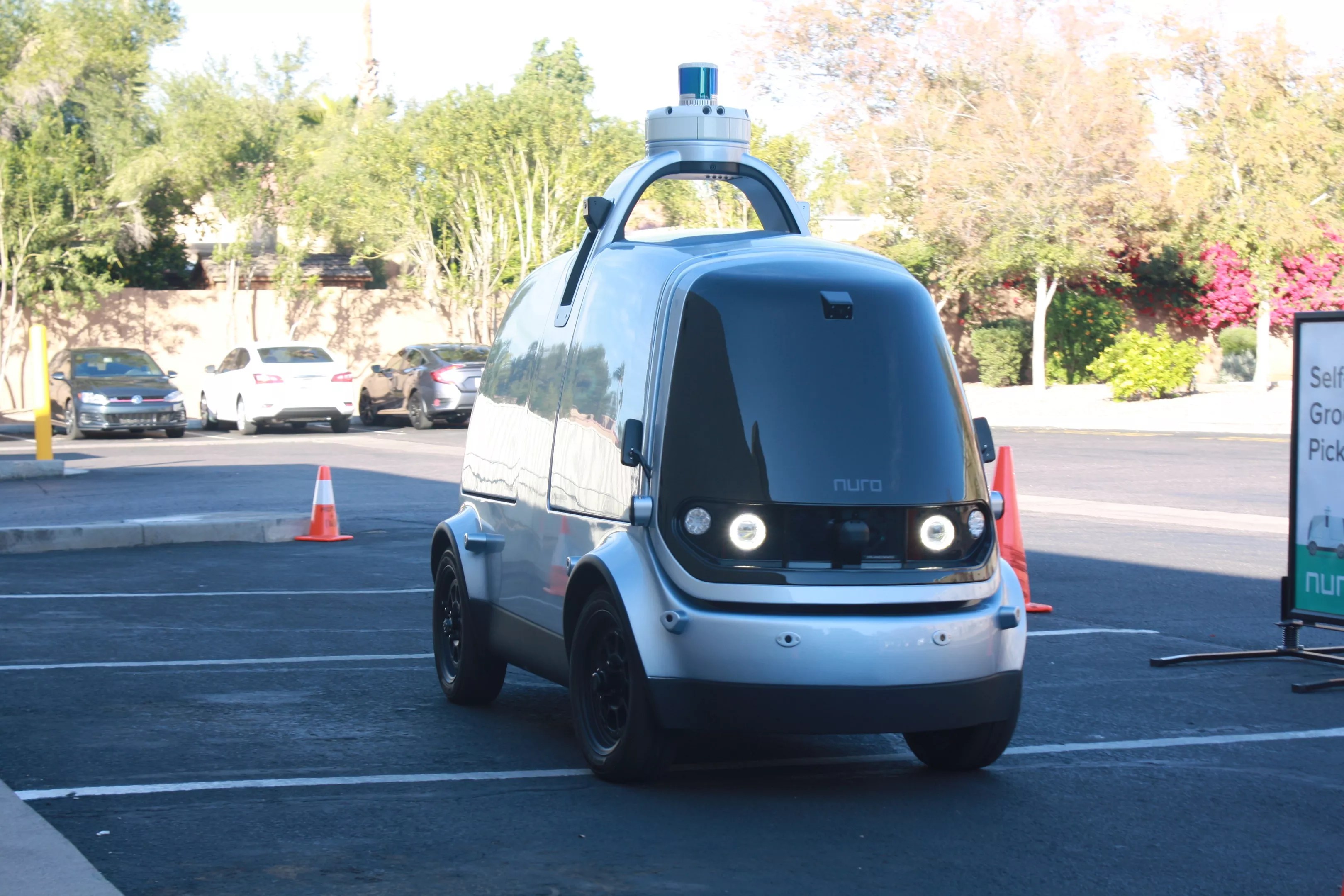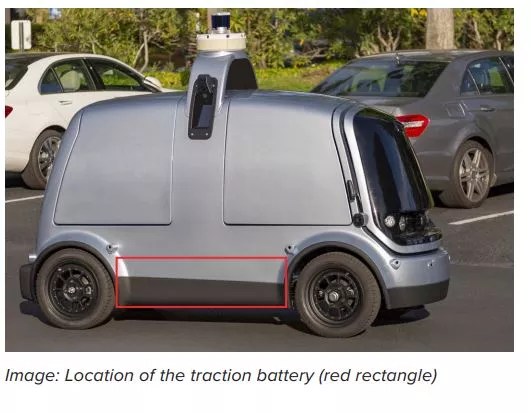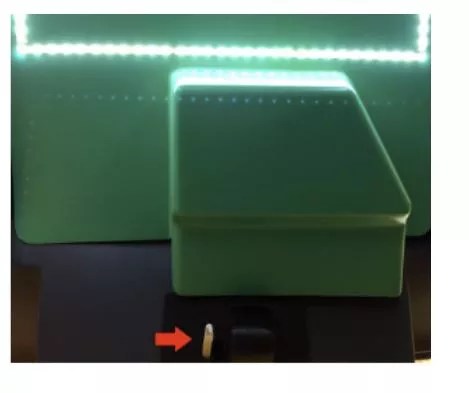
Tyler Tanner

Audio By Carbonatix
How would police stop one of the new, unmanned Nuro R1 delivery vehicles now working in Scottsdale if it was violating the law or out of control?
Last month, the California autonomous vehicle company gave Arizona police the answer to that and other questions about the vehicles’ operations in a slick, eight-page document called “Nuro Arizona Law Enforcement Protocol for Fully Autonomous Vehicles.”
Submitting a “law enforcement interaction protocol” to the state is one of the few rules Governor Doug Ducey put on driverless vehicle companies in an updated executive order on March 1. The protocol must include “information educating relevant law enforcement agencies and other first responders on how to interact with fully autonomous vehicles in emergencies and traffic enforcement situations, contact information for insurance and citation purposes, and any other information needed to ensure the safe operation of fully autonomous vehicles in Arizona.”
Uber wasn’t required to adhere to that rule when one of its self-driving cars killed a Tempe pedestrian on March 18 because the car had a backup driver behind the wheel.
This year, make your gift count –
Invest in local news that matters.
Our work is funded by readers like you who make voluntary gifts because they value our work and want to see it continue. Make a contribution today to help us reach our $30,000 goal!

The document for police explains where to find the battery compartments in the vehicles.
Nuro
Nuro put its R1s, which have no space for drivers or passengers, into commercial service this week in a much-touted partnership with supermarket giant Kroger. Scottsdale customers in the 85257 ZIP code can order groceries from the Fry’s food store at 7700 East McDowell Road and have them delivered by the diminutive, four-wheeled R1s for a flat $5.95 fee. The electric vehicles have room for several pounds of groceries that must be loaded and unloaded by humans. For now, Kroger said, they’ll stay in the 25-mph zones of the neighborhood around the Fry’s, never going onto McDowell Road, a busy thoroughfare.
The R1 can’t have a backup driver – instead, while the program remains in a test phase, the vehicles will have whole backup vehicles.
As the protocol guide explains, a “safety chase” vehicle will usually be following an R1. It will look like an ordinary vehicle but “be specially equipped to monitor, evaluate, and serve as a backup control platform for R1.”
Workers in the chase vehicle will monitor the R1’s driving, including whether a police officer is trying to make a traffic stop.
“If law enforcement wishes to direct the Nuro vehicle to pull to the side of the road while in operation, the most efficient method is to pull over the safety chase vehicle, when present, in the same manner as any other vehicle on the road,” the guide states. “The operators in the safety chase vehicle will pull over the Nuro Unmanned Vehicle in convoy.”
If the chase vehicle is not present, police can call a hotline if necessary “to remotely disable the Nuro vehicle and safely remove it from the roadway.”
At the direction of police, Nuro specialists can take the R1 out of autonomous mode and operate it by remote control. The company agrees not to put the stopped vehicle back in autonomous mode until completing a safety checklist that includes cops giving “verbal confirmation.”
Handing over a driver’s license and insurance would be tough for the R1, which as of now has no robotic arms. A Nuro Operating Specialist would give documentation to an officer if he or she is in the chase vehicle. If no chase vehicle is present, Nuro will basically send an email:
“Relevant documentation for all Nuro vehicles can be provided electronically to Law Enforcement upon request to the Nuro Operations Specialist in communication with the requesting individual.”
The guide, which the Arizona Department of Transportation released upon request to Phoenix New Times on Thursday, provides a few other details about the R1’s operation that weren’t in the news release this week by Nuro and Kroger.
For instance, the vehicles have door-release handles on the inside of their cargo compartments. Such a feature, presumably, could prevent a child from being trapped inside.

The R1 unmanned vehicles have door-release handles on the inside.
Nuro
Also, vehicles may be soon plying an area larger than one ZIP code. “The vehicle may occasionally be in the immediately adjacent area, which includes portions of Scottsdale, Tempe, and Phoenix, as well as public roads in the Salt River Pima-Maricopa Indian Community.”
Nuro says its vehicles are not able to travel autonomously outside of a pre-mapped area that has been driven by the company’s autonomous vehicles with backup drivers. Nuro has used self-driving Toyota Priuses with backup drivers for the last few months in its partnership with Kroger, and rolled out the R1 a few weeks ago in tests that were spotted by local media.
The R1 uses 14.1-kwh, 48-volt lithium battery packs located in the bottom-center of the vehicles that use “considerably less voltage” than standard electric vehicles for passengers, the guide states, adding information on how to deal with a fire. “Do not use small quantities of water,” the company recommends.
If officers find a vehicle that’s stopped, that doesn’t mean it’s broken, the guide indicates – “it may have detected an obstacle that requires it to stop for safety reasons.”
Nuro will take immediate action if a vehicle is stuck somewhere, which may involve a Nuro worker arranging for a tow. The chase vehicles also contain tow hooks.
Scottsdale police told New Times earlier this week they received the protocol guide on November 1.
“While we don’t anticipate any issues outside what we normally see with vehicles operated by humans, we are prepared to respond regardless,” a police spokesman said.
Nuro released an online safety report in September that explained how the vehicles aren’t designed to go more than 25 mph, and that remote operators will be monitoring them “at all times.”
“These operators are able to address any issues that come up while the vehicle is driving, parked, or delivering. If necessary, the operators can perform a full wireless command override, and the vehicle hosts a number of other camera-based security features designed to minimize any dangerous intervention in its operation.”
A similar law enforcement protocol document for Waymo vehicles advises officers to minimize their time in front of the vehicles if the engine was running.
The Nuro document and the commercial operation of these vehicles on Arizona roads raise all sorts of questions, like how authorities would determine who at Nuro was at fault if the R1 hit and killed a pedestrian like Uber’s vehicle did, or when the chase vehicles might stop being used. Nuro didn’t return messages.